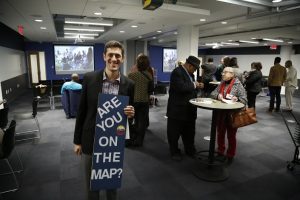Thousands of residents and hundreds of organizations work every day to make Detroit’s neighborhoods strong and vibrant. They often do it in a vacuum. There hasn’t been a way to help them easily find and collaborate with other block clubs, neighborhood associations, community development organizations, and neighborhood improvement organizations throughout the city.
Thanks to d[COM]munity, a new interactive map and directory from Community Development Advocates of Detroit (CDAD), one click of a button can now connect those groups to their sister and brother organizations. That will open up a whole new world of sharing information and streamlining plans to reimagine Detroit’s neighborhoods.
At the November launch at Detroit’s TechTown, Sarida Scott, CDAD executive director, encouraged organizations to become an integral part of this huge network of community-based organizations.
“If you are a community organization please get on the map,” she said.
A user-supplied information network of neighborhood associations and programs, the community organization mapping (“COM”) system has been in development for two years and is among the first local resource navigation tools of its kind. It might be described as part-White Pages, part-GPS, and part-virtual tour.
By responding to an online CDAD survey that requests information about the program or agency, a user can have his or her program’s name, address, telephone number and services offered listed with d[COM]munity.

Erica Raleigh, executive director of Data Driven Detroit, which provided the technical support for the mapping initiative, echoed Scott’s sentiments.
“I am so excited that we will have this resource … this system … to move forward,” Raleigh said.
Aaron Goodman, CDAD’s community engagement manager, told The HUB exposure was the primary goal in launching the map system, which he helped spearhead. d[COM)munity will become a valuable tool for government and residents because they can now easily identify their city council districts and service areas, along with the grassroots and support programs in those areas. Neighborhood activists may find the tool useful for network.
“The work of all the neighborhood groups, people who do all the groundwork, is really important,” Goodman said.
Community organizations can be identified or located using searches by zip code, services offered and other features Goodman demonstrated at the launch. A click of a button can display a brief, but thorough, profile of any agency that creates an account and supplies information to the system.
d[COM]munity launched Nov. 30. Funding was provided by the W.K. Kellogg Foundation. CDAD also acknowledged JP Morgan Chase. Tosha M. Tabron, its vice president of global philanthropy and CDAD board chair, supported the initiative.
![Phyllis Edwards (center), Bridging Communities Inc. Executive Director, CDAD Member and user of d[COM]munity joins other guests at d[COM]’s launch event.](https://www.thehubdetroit.com/wp-content/uploads/2015/12/L7A1309-300x200.jpg)
“Like the neighborhood where I was raised in Memphis, Tenn., we should all know each other,” she told the audience. “Let’s all get on the map.”
Photos by Troy Anderson, CDAD

![d[COM]munity to digitally link all community organizations in Detroit with interactive map, increase collaboration d[COM]munity to digitally link all community organizations in Detroit with interactive map, increase collaboration](http://thehubdetroit.com/wp-content/uploads/2015/12/File_000-650x400.jpg)

I believe that virtual reality and immersive experiences is the new thing. Google's Cardboard project is a good example of how this new technologies could be applied. People can create Google 360 virtual tours and share them with the world in a new and unique way.
Nice post
technology will change the world..
nivce post
good technology…
great artice
Immersive experiences is the new thing. Google's Cardboard project is a good example of how this new technologies could be applied.